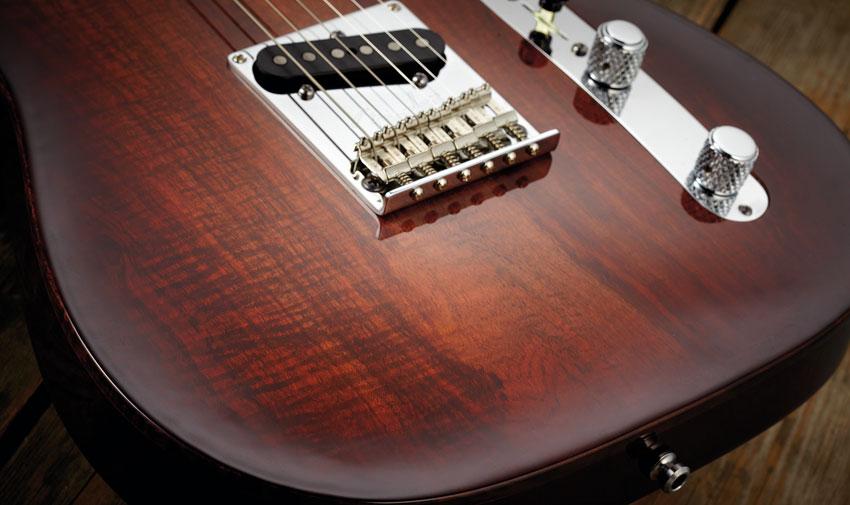MusicRadar Verdict
Chambered body, carved hardwood top, Wide Range neck humbucker - it shouldn't work, but it does.
Pros
- +
Upmarket looks and feel. Build quality.
Cons
- -
Setup. Bridge pickup tones.
MusicRadar's got your back

Fender Select Carved Blackwood Top Telecaster SH

Body

Pickup

Neck
Launched in 2012, the Select series is the top tier of Fender's standard production ranges before you enter Custom Shop realms. For 2013, a selection of new models were added: a carved top Jazzmaster, HH and Thinline Teles, and new versions of the Strat HSS and the Carved Blackwood Top Telecaster, reviewed here.
"The neck has slightly rounded fingerboard edges that help create a played-in feel"
It's easy to dismiss the Selects as simply upmarket 'posh' Fenders. Yes, this Telecaster is spec'd with a carved 14mm Tasmanian blackwood top on a 39mm chambered alder back, but by design it aims to fit in style between the American Vintage and Deluxe ranges.
A vintage/posh collision if you like, centring on top-quality woods but without the garish colours, multi-mollusc inlays or gold-plated hardware that are the typical adornments of high-end guitars.
The Tele's 22-fret neck uses a standard unbound rosewood slab 'board on a very flame-y maple neck, and you can clearly see the fret slots on the fingerboard edges. The neck has slightly rounded fingerboard edges that help create a played-in feel.
The 2013 look
As with the 2012 Selects, we're hardly spoilt for colour options - there's only one. The thicker Tele body with its violin-like arching is chambered to reduce weight and impart a different resonance. This blackwood top has an interesting if not spectacular koa 'lite' type grain. The finish is quoted as being a lacquer (aka nitrocellulose) topcoat: it's a little mottled, noticeably on the carved face.
Hardware remains the same on these 2013 Selects with the American Standard Tele bridge, as used on non-vintage higher-end Fenders. There are vintage-style bent-steel saddles and, as on the 2012 Tele, the height-adjustment screws protrude sharply.
Again, we get the rear-locking dual-height tuners, the bottom three strings have standard height posts, and those for the top three have shorter posts, increasing the strings' back angle behind the nut.
Feel and sounds
The Tele's bridge pickup seems fairly vanilla - there's plenty of honk and high end, but it's somehow more controlled than our reference '69. It's a little more open in the midrange, and some of that would seem to come from the more Strat-like saddles.
The typically wider mix pickup tone can be thicker or thinner depending on whether you select the full or single-coil mode of the Wide Range 'bucker, while the full-coiled neck pickup on its own is an excellent addition.
Clean, it doesn't sound overly muddy, and with a little tone and volume reduction you have a good softer jazz voice. Conversely, with some gain and volume there's more clarity, power and bite compared to the Tele's usually rather muted output. But if you like that sound, as many of us do, the single-coil voice sound gets much closer.
Exactly what the chambered alder back and blackwood top construction bring is harder to pinpoint. At stage volumes, though, there's a very attractive and subtly woodier resonance, and the full-coiled neck pickup takes a slight move into more ES-335-like territory.
Aside from a couple of issues - it would benefit from a tougher setup with increased neck pitch, and it has a less-than-flat finish - this is a highly enjoyable guitar that broadens the original's visual and tonal reference points without going too upmarket in looks.
The Tele suits this treatment, and with attractive sub-£2k street price, despite the competition from numerous boutique brands, this is far from shabby.
Dave Burrluck is one of the world’s most experienced guitar journalists, who started writing back in the '80s for International Musician and Recording World, co-founded The Guitar Magazine and has been the Gear Reviews Editor of Guitarist magazine for the past two decades. Along the way, Dave has been the sole author of The PRS Guitar Book and The Player's Guide to Guitar Maintenance as well as contributing to numerous other books on the electric guitar. Dave is an active gigging and recording musician and still finds time to make, repair and mod guitars, not least for Guitarist’s The Mod Squad.
“I have an original 909 – every time I try to use it I feel like I’m ruining it”: House hero Riva Starr on his studio essentials and his love of analogue synths
“A synthesizer that is both easy to use and fun to play whilst maintaining a decent degree of programming depth and flexibility”: PWM Mantis review
“I feel like that song had everything we needed to come back with”: Bring Me The Horizon’s Lee Malia on Shadow Moses, its riff and the secrets behind its tone, and why it was the right anthem at the right time










